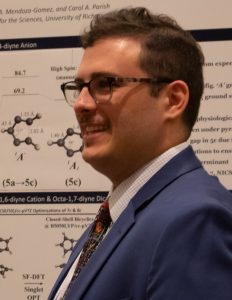 Dr. Dominic Sirianni is an assistant professor in Daemen University’s Natural Sciences department. We talked to Dr. Sirianni about everything from the Sirianni Lab to WildKets.
Dr. Dominic Sirianni is an assistant professor in Daemen University’s Natural Sciences department. We talked to Dr. Sirianni about everything from the Sirianni Lab to WildKets.
You’re an assistant professor of chemistry at Daemen. What courses do you teach?
I teach in the first-year chemistry sequence, including Chemistry I & II lecture (CHE 110 & CHE 111) and Chemistry II lab (CHE 111L). Additionally, I teach upper-division courses for Biochemistry B.S. students, which primarily include Biophysical Chemistry lecture & lab (CHE 303 & CHE 303L), but this semester also includes Quantitative Chemical Analysis (CHE 311). Finally, I teach elective coursework in Computational Chemistry, which is offered as CHE 147, 247, 347, & 447 depending on students’ background in chemistry coursework.
You also lead the Sirianni Lab here on campus. Can you talk about this research and what student researchers do?
First and foremost, the Sirianni Lab is a group of scientists who explore chemical questions through a computational lens. We actually call ourselves the WildKets (an admittedly terrible quantum mechanical pun on Daemen’s athletic mascot) because all of us are along for the same ride: learning about these phenomena together.
To do this, we WildKets apply quantum mechanics, scientific computing, and software engineering to investigate challenging open questions at the intersection of chemistry, biology, and physics. This includes exploring chemical reactivity, molecular structure and properties, and how biological processes like enzyme catalysis and molecular recognition are impacted by their chemical environments. While we are currently working on a wide variety of projects, they all share the underlying philosophy: trying to understand why chemistry happens the way that it does.
On the day-to-day, this involves performing and analyzing quantum chemical computations using computers housed at supercomputing facilities around the country (rather than physically at Daemen). This involves a lot of staring at a computer screen – and doing whatever you can to make the computer do what you want – which, although not always glamorous, provides us the space to play with the science. We try things. We learn. We experiment. We also get to break things – but without needing to be concerned with safety. Taken together, this process provides insights at the molecular level, which experimental approaches often cannot, which in turn can help experimental scientists interpret their results and even make predictions before performing an experiment that might not work. So even though it can be challenging, it’s just plain fun!
You recently had a paper published in the Journal of the American Chemical Society, one of the flagship journals in chemistry. What is the paper on, and how did it come about?
This paper explores several reactions that can be used to generate diradical molecules, which, beyond their interest from a basic chemistry perspective, may, in the future, have anti-tumor applications. Radicals are molecules that have an unpaired, dangling electron that can attack and react with anything nearby. Their reactivity is why dreaded “free radicals” in the body can cause so much damage, even causing cancer in the first place. Diradicals are even more dangerous because they have two dangling electrons and double the potential for damage. Funny enough, this double trouble is actually why diradical-producing reactions are pharmacologically interesting: if this chemistry could be controlled, it might be possible to selectively generate diradicals in cancer cells, both halting tumor growth and destroying the cells in the process. This is actually a well-established idea, but progress stalled out in the early 2000s because the reaction necessary to generate the diradical called the Bergman cyclization doesn’t occur spontaneously at body temperature. As a result, pretty much everyone abandoned ship – but thankfully, right about that time, Prof. Carol A. Parish (my future postdoctoral advisor) started collaborating with Nobel laureate Prof. Roald Hoffmann and had an idea: could the Bergman cyclization work in ionic systems to make diradicals at a lower temperature than for the conventional approach? As it turns out, after ~20 years of work, it can!
How will the paper fit into your research program here at Daemen?
This paper actually serves as the foundation for one of the lab’s major scientific thrusts. Last year, Jill Baltzley (BS NatSci/Health Sci PA Studies, ‘26) found a promising way to control the neutral version of the reaction – the one that everyone abandoned 20 years ago – about which she presented at a national conference this past summer (more on that in next week’s Daemen Voice!). Now, Kade Bidwell (BS Biochemistry, ‘26) and Niya Colon (BS Cytotechnology, ‘25) are exploring that new direction, and I have several other ideas about this chemistry that are ready for any new WildKets to sink their teeth into!
